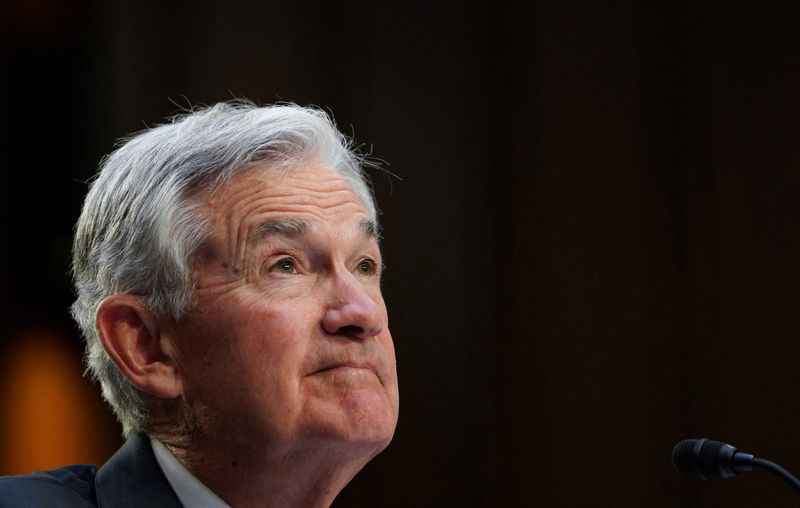By Howard Schneider
WASHINGTON (Reuters) - The U.S. Federal Reserve begins a two-day meeting on Tuesday, with some top central bank watchers saying it could well pause further rate hikes given recent trouble among banks or even delay releasing new economic projections because the outlook is so clouded.
Or not.
The Fed meeting concludes Wednesday with the 2 p.m. EDT (1800 GMT) release of a new policy statement and a 2:30 p.m. press conference by Fed Chair Jerome Powell, and if all goes as planned, the release of new projections for the economy and path of interest rates.
But as much as at any point since the March 2020 onset of the COVID-19 pandemic, the full dimensions of the outcome seem in doubt as officials try to balance the need to keep pressure on the economy to lower inflation, strike the right note of caution about financial stability, and avoid any missteps that could make investors think things are worse - or better - than they are.
"This is all a bit of a mess," Krishna Guha, vice chair of ISI Evercore and a former New York Federal Reserve official, wrote ahead of a Federal Open Market Committee meeting that has veered from a dead-certain jump in interest rates two weeks ago to a speculative morass.
After high-profile U.S. bank failures beginning March 10 and the emergency rescue of Europe's Credit Suisse over the weekend, markets appeared calmer on Monday with some sense that actions taken by the Fed and other central banks would keep the financial system stable - and not allow it to degenerate in a series of failures.
Investors in securities tied to the target federal funds rate still put a roughly 70% probability on policymakers approving a quarter-point rate increase, which would push the target federal funds rate to a range between 4.75% and 5%. The yield on the 2-year Treasury note - particularly sensitive to Fed policy expectations - rose steadily through the day, adding roughly a quarter of a point from the overnight low and approaching 4%.
But, for a security tied closely to expectations about Fed policy, that still marks a dramatic fall from March 9 when the 2-year topped 5% and markets were digesting a hawkish message from Powell that the policy interest rate would need to rise higher and perhaps faster than anticipated.
IT'S TRICKY
The March 10 failure of Silicon Valley Bank threw the outlook into turmoil, and while the situation has settled down, the sense of flux seeped deeply into the debate about what the Fed is likely to do with a suddenly tricky decision over how to keep pressure on the economy to slow inflation without pushing a swath of midsized banks to the snapping point.
Analysts trying to parse what recent bank stress might mean said a coming credit contraction could be the equivalent of an additional quarter point Fed rate increase, or as much as a recession-inducing 1.5 percentage points, rendering further rate hikes obsolete.
"Could they? Will they? Should they?" EY-Parthenon Chief Economist Gregory Daco puzzled in an essay. "Yes, the Fed could continue to tighten monetary policy...Yes, the Fed will likely raise the federal funds rate by 25 basis points...No, the Fed shouldn’t...The optimal approach would be to pause" and take stock of whether bank stress will or will not cause a problem.
KPMG Chief Economist Diane Swonk went further, saying the Fed should not only delay any further rate hikes, but also withhold economic projections scheduled to be released at the conclusion of this week's meeting because they would "create more chaos than clarity."
"Providing guidance on where individual members of the leadership of the Federal Reserve system see rate hikes and the economy going now seems counterproductive," Swonk wrote, given the possibility that any projection - whether for continued higher rates to fight inflation or a dovish path in deference to financial stability - could be misconstrued.
But her recommendation - and she wasn't alone in suggesting the Fed might delay its quarterly Summary of Economic Projections - also hinted at the risks involved when a central bank does anything unexpected.
Since the Fed began publishing its quarterly estimates in 2012, the only time it has failed to do so was in March 2020 when the onset of the coronavirus pandemic put the economy on the verge of collapse - a comparison the Fed would not want people to make with the current state of affairs.

Bank of America (NYSE:BAC) analysts said they thought the Fed would proceed with a quarter point increase, but shape the message in its statement and in Powell's press conference to take stock of the last two weeks.
"The emergence of financial stress is likely to indicate to the committee that monetary policy is closer to being 'sufficiently restrictive' than some may have thought previously," BOA economists wrote. "At the very least, stress in financial markets suggests that the Fed should proceed with caution."